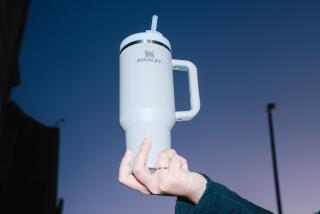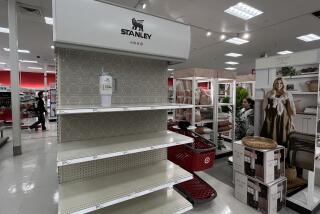Hoping to Milk Profits From Craze : Hobbies: Manufacturers and promoters of the glossy caps, long a popular collectible in Hawaii, hope to whip up a frenzy on the mainland.
- Share via
Some call them POGs. Others call them Trovs, Hero Caps, SkyCaps and Tonx.
Whatever their trademark, a handful of businesses are betting that milk bottle caps, long a popular collectible in Hawaii, are ready to take off on the mainland.
These aren’t your grandfather’s milk caps--the staid but functional cardboard stoppers that date back to the turn of the century. Today’s milk caps are glossy, four-color affairs that incorporate bright graphics, holograms and the likenesses of media heavies ranging from NBA star Shaquille O’Neal to the X-Men, Marvel Comics’ popular comic book and cartoon show characters.
Most of these tops couldn’t stop milk from dribbling out of a bottle. But that doesn’t matter to kids who collect them like sports trading cards or use them as playing pieces in a Hawaiian game that’s similar to shooting marbles or flipping sports trading cards, which has led several Orange County schools to ban the caps from their schoolyards.
*
Islanders have been collecting caps for decades, but demand soared dramatically in the past two years and manufacturers responded by flooding the islands with about 1 billion of the discs, which are about the size of a silver dollar.
That unexpected wave of interest surprised Stanpac, a Canadian company that had cornered the decidedly limited market for milk caps after dairies switched to plastic and cardboard milk containers that need no tops and other cap manufacturers left the business.
Last year, Stanpac shipped about 150 million wax-covered cardboard caps, up from about 1 million caps annually in the late 1980s. As Stanpac’s orders skyrocketed, competitors began shipping what Hawaiians called “faux” caps--cardboard pieces without Stanpac’s functional pull tab, staple (to hold the tab in place) and paraffin coating.
Cap manufacturers and promoters now hope to milk additional profits by whipping up a cap frenzy on the mainland.
“There’s at most a couple million people over there, and we shipped 150 million caps in 1993,” Stanpac owner Steve Witt said. “Put the numbers together with the mainland population and the (potential) numbers are staggering. I don’t think there are enough trees to make all those caps.”
Not everyone in the collectible business is as optimistic about the future of milk caps.
“Milk caps are popular only in three places outside of Hawaii--Southern California, Washington and Florida,” said Harris Toser, an editor at Non-Sport Update, a magazine for collectors. “A lot of manufacturers are trying to make it work, and they’ve been trying for 1 1/2 years. But it’s a tough battle because milk caps never had a real history as a collectible on the mainland.”
Despite a flurry of interest in Southern California--some school principals have banned caps from their schoolyards on the grounds that it is a form of gambling--milk caps remain relatively unknown elsewhere in the country. There are signs, though, that promoters are succeeding in their bid to turn the discs into a nationwide craze.
The New York Times’ “Surfacing” column recently included milk caps on a list of up-and-coming trends--albeit, alongside men’s ties fashioned from jungle camouflage and part-time chefs who’ll whip up dinner in your home.
*
Bill Hodson, a former Newport Beach stockbroker who founded TROV USA, an Orange-based milk cap distributor, said interest is perking up from San Diego to Sacramento. He’s also ready to start marketing TROV-brand caps in Arizona, Northern California and Utah.
Some trading card companies have entered the fray, and professional sports leagues are experimenting with milk caps as promotional items.
Durham, N.C.-based SkyBox International introduced a line of milk caps in 1993, shortly after its executives witnessed Hawaii’s cap fever firsthand during a collectibles trade show held in Honolulu in early 1993. SkyBox signed Magic Johnson as its spokesman and shipped 4 million milk caps by year’s end.
Some card manufacturers are steering clear of milk caps. “Milk caps are interesting in Hawaii and pockets of California,” said Camron Bussard, a spokesman for Carlsbad-based Upper Deck. “But our market research doesn’t support a national market or interest in the product.”
Even Stanpac is treating revenue from the milk-cap craze as icing on the fiscal cake. “When we put together our business plan for the coming year, we based it on industrial business, not collectibles,” Witt said.
Alan Rypinski, who used his marketing skills during the early 1980s to turn Aliso Viejo-based Armor All Products Corp. into a household name, believes milk caps are ready for an unlimited run. And he’s created the World POG Federation in Costa Mesa to share in the action.
Rypinski learned about milk caps from a television news report. Within a few months he had acquired the POG trademark from a Hawaiian dairy that’s been marketing POG--it stands for Passion Orange Guava--juice for 25 years. Rypinski also signed an exclusive contract to distribute the traditional milk caps manufactured by Stanpac.
POG is arguably the oldest and best-known trademark name in the milk cap industry, observers said, and most Hawaiians refer to milk caps simply as POGs. Rypinski hopes the POG name and heritage--when coupled with his company’s marketing and advertising expertise--will catapult World POG Federation into a leadership role.
*
But Rypinski acknowledged that milk caps could become the latest in a string of overnight fads if manufacturers and distributors repeat mistakes made in Hawaii. There, the collectible value of many milk caps plummeted, after greedy manufacturers flooded the market. Also, many consumers were burned repeatedly by manufacturers who turned out cheap imitations.
“Nobody was leading the way, the industry was out of control,” Rypinski said. “And, there was simply bad product being released . . . stuff that would disintegrate in your pocket.”
Milk cap promoters also acknowledge that the different trademarks used to describe milk caps are confusing to consumers. POGs, SkyCaps, Hero Caps, Trovs and Tonx are among the names now being used.
This name game doesn’t bother Houston-based Coca-Cola Foods, which last month paired its Hi-C drink line with Marvel Comics’ X-Men in a nationwide milk cap promotion. Marvel created limited edition artwork that adorns caps that are being stuffed into Hi-C six-packs.
Coca-Cola Foods, which is stuffing three milk caps into each eight-pack of specially labeled Hi-C drinks, views the caps as a double-barreled promotion.
“I know as a marketer that I want (something special) to sell product,” said Caryn Crump, general manager of Coca-Cola’s grocery marketing operations. “But I know as a mother of two kids that consumers want something of value . . . and a lot of these milk tops are selling for many dollars.”
Initial reports are promising, Crump said: Kids are “already shaking boxes in stores, trying to see which (caps) are included in the packages.”
Coca-Cola’s involvement could spark dramatic growth in the promotional value of milk caps, which would in turn stimulate sales of collector caps, said Kerry J. Smith, managing editor of Promo Magazine, which tracks promotional programs and marketing.
“In this (promotion) business, everyone’s afraid to be the first one into the pool,” Smith said. “But the involvement of a Coca-Cola could give it the push needed.”
“The big question is when does it get over the Rocky Mountains to the rest of the country?” Hodson said. “It will take a major international corporation to step up to the plate, put the things out there and promote them.”
Professional sports organizations also are experimenting with milk caps.
NASCAR, the sanctioning body for stock car racing in the United States, has licensed DLT Marketing in St. Paul, Minn., to produce milk caps bearing the likenesses of its top drivers and cars. And several NASCAR sponsors are using milk caps in promotions.
“We’ve had a tremendous response from consumers, especially in the Southeast,” said DLT President Debbie Lynne-Tyson
Late last year, Rypinski said, a major Mexican soft drink company bought more than 300 million of the small, cardboard discs from another cap company for use in a promotion. Rypinski envisions milk caps becoming an international marketing tool used by automobile and computer manufacturers, fast food restaurants, municipalities and universities.
Smith said milk caps are drawing considerable interest overseas: A number of European and South American marketing firms requested additional information after his magazine wrote about milk caps last year.
Still, Smith questions whether “a piece of cardboard can compete in an age when kids are spending $60 to $100 for Sega game cartridges. . . . It might be great for 40-year-olds who want to hark back to a simpler time, but is it really for kids who are playing in game arcades, listening to CDs and playing with computers?”
Rypinski believes that parents and educators eventually will embrace milk caps when they understand that kids will drop their joysticks in order to pick up the cardboard discs.
“We refer to (POGs) as the old-fashioned game of the future,” Rypinski said. “Kids love it because they can invent their own games and it’s not intimidating . . . anyone can play it.”
Some who track trends and fads say the slow growth of milk caps on the mainland is actually a healthy sign.
“When things are so popular that the curve goes straight up, it almost always disappears overnight,” said Craig Masuoka, co-owner of California Color Products in Carson, which produces stickers for Southern California’s mercurial surf and skateboard companies. “But if it builds slowly over a longer period of time, it’s more than a fad, it’s a trend.”
More to Read
Inside the business of entertainment
The Wide Shot brings you news, analysis and insights on everything from streaming wars to production — and what it all means for the future.
You may occasionally receive promotional content from the Los Angeles Times.










